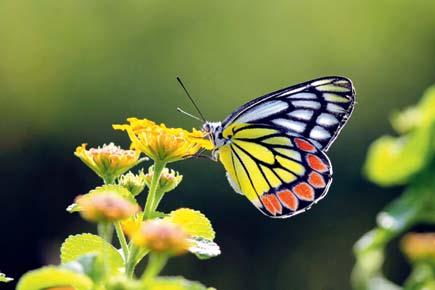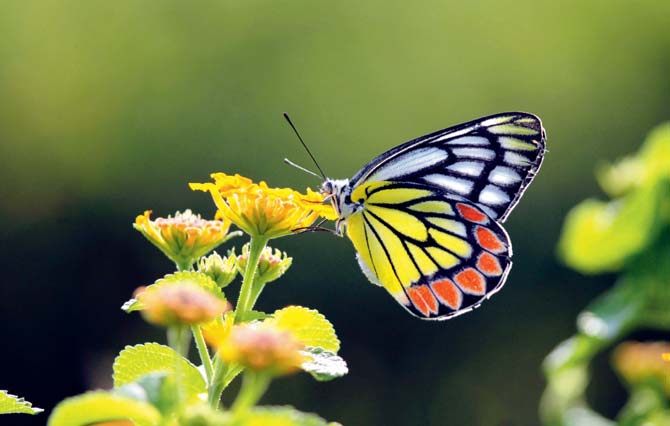Social media is abuzz with images, discussions and concerns over the smog, pollution and poor visibility affecting New Delhi, Mumbai and other cities


Butterflies at Hanging Garden. Pic/Poonam Bathija
ADVERTISEMENT
 Social media is abuzz with images, discussions and concerns over the smog, pollution and poor visibility affecting New Delhi, Mumbai and other cities. Many of my friends are deeply polarised over how, when vehicular pollution is so perpetual, arguing against firecrackers is being biased against the time-bound festivities. I wonder if the same argument would’ve held ground, had it been a medical report handed over to you by your physician, wherein you were asked to choose between protecting your lungs and kidneys. Can we be careless and argumentative when looking at the health report of our Earth, of which we are an integral part? What happens to the planet happens to us.
Social media is abuzz with images, discussions and concerns over the smog, pollution and poor visibility affecting New Delhi, Mumbai and other cities. Many of my friends are deeply polarised over how, when vehicular pollution is so perpetual, arguing against firecrackers is being biased against the time-bound festivities. I wonder if the same argument would’ve held ground, had it been a medical report handed over to you by your physician, wherein you were asked to choose between protecting your lungs and kidneys. Can we be careless and argumentative when looking at the health report of our Earth, of which we are an integral part? What happens to the planet happens to us.
The other trending subject was the NGC film Before the flood, in which actor Leonardo DiCaprio argues the need to reassess our actions and lifestyle choices, to combat climate change. It was a moving and captivating film covering literally every continent. But, what stuck with me was the fact that with increased climate change refugees and human migrations to urban centres, the need for connect with nature and green as a form of destressing, is going to be imperative. The options are going to weigh between manicured gardens, public parks, sports fields and natural green or open spaces. Here again, those with higher spending capacities can gain access to literally any part of the world, but the masses will be fighting for entry into the limited and shrinking free-access green spaces.
The effects of urbanisation and increasing human densities on the quality of life of Mumbaikars were identified as early as the 1880s. When researching the history of public gardens and open spaces in colonial Bombay City, the terraced Hanging Garden on Malabar Hill, along with the tinier Kamla Nehru Park (KNP) popped out prominently. To provide relaxation space and prevent potential contamination of Mumbai’s main water reservoir from the activity of the adjacent Tower of Silence (Parsi Crematorium Well), the Sir Pherozeshah Mehta Gardens were designed in 1881 by Ulhas Ghapokar. These two gardens set across the road have been age-old attractions for children, the KNP for its Old Lady’s Boot and the Hanging Garden for its topiaries. Various shrubs and trees have been clipped into ornamental shapes such as bullock cart, giraffe, elephant and deer. But the gardens are not merely ornamental.
Located on an undulating hill, the contours of the gardens and adjacent slopes support a lot of wild vegetation which attract over 70 species of butterflies, amphibians, reptiles, resident and migratory birds, and a healthy number of palm squirrels and an ephemeral population of macaques too. Last week, in just an hour, during a nature trail we sighted over a dozen birds, viz. Black drongos, Black kites, Rose-ringed and Alexandrine Parakeets, Palm swifts, Grey Wagtails, Red-vented and Red-whiskered Bulbuls, a few golden orioles and large flocks of house sparrows, pigeons, crows and mynas too.
This season is ideal to visit these parks as they are full of colourful butterflies, such as the tailed jay, common mormon, blue bottle, plain, striped and blue tigers, great orangetips, gulls, jezebel, great and daniad eggfly, common evening brown and an occasional blue mormon too. Alternatively, you can night-cycle to the garden steps to sight spotted owlets and hear the cacophony of the flying foxes (bats), enjoying the figs.
The values of the park are multiple. But the question ahead of us is, ‘Is it worth fighting to protect a 135-year old heritage garden, against the onslaught of roads and mindless urbanisation?’
Write to Anand at sproutsenvttrust@gmail.com
 Subscribe today by clicking the link and stay updated with the latest news!" Click here!
Subscribe today by clicking the link and stay updated with the latest news!" Click here!






